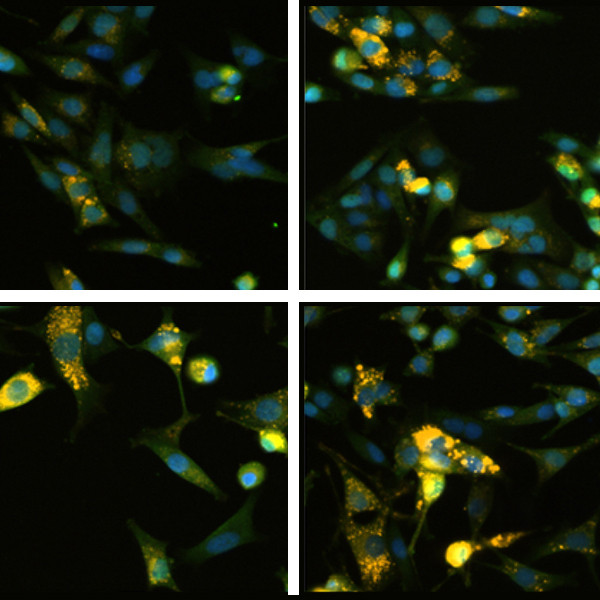NCATS’ Screening Studies Focus on Making Melanoma Cells More Visible, Advancing Efforts to Overcome Roadblock in Therapy

NCATS scientists have identified several compounds that potentially could improve the effects of a therapy for a deadly skin cancer, metastatic melanoma. Here, they have compared the effects of three compounds and a control on human melanoma cells. The panel on the far left represents the effects of a control compound. In the other three panels, cells colored green and orange show that the compounds increased the activity of important proteins, indicating that the compounds could be useful in enhancing therapy. (Dextras et al., Scientific Reports)
March 23, 2022
Finding the right compounds for new uses in treating a disease or improving a therapeutic approach can be tedious, time-consuming work. High-throughput screening is one way to speed up the process. It enables scientists to test the potential usefulness of thousands of compounds at a time.
NCATS scientists recently used this approach to help colleagues at the National Cancer Institute (NCI) identify existing compounds and drugs that could lead to improvements in a therapy for a form of metastatic melanoma, a potentially deadly skin cancer. The therapy, called adoptive cell transfer, aims to boost the patient’s immune system against the disease. But the therapy can stop working when melanoma cells turn off a signal on their cell surface that helps the immune system recognize them.
One possible solution is to make the cancer cells more visible to the immune system. To do that, NCATS translational scientist Marc Ferrer, Ph.D., former NCATS scientist Anju Singh, Ph.D., now with NCI, and their team — in collaboration with scientists at NCI and the National Institute of Allergy and Infectious Diseases — developed a specific assay, or test, for melanoma cells. The assay identified compounds that could increase the activity of an antigen, a protein on the surface of melanoma cells. The lack of this kind of test had hampered previous research efforts to enhance the effects of immune therapy on melanoma cells.
Increasing antigen activity could make the tumor cells be recognized more easily by the immune system. Using high-throughput screening, the NIH scientists tested nearly 500 compounds at the same time for their ability to improve antigen and immune recognition. The scientists found 36 compounds that could do this.
With the help of additional assays that measured other characteristics of the compounds, including toxicity, the researchers narrowed the list to four candidates. Each one works differently, with different biological effects that result in the desired immune response. The researchers reported their findings March 30 in Scientific Reports.
"This is a proof-of-principle study,” Ferrer said. “We showed we can find and repurpose small molecules that can change antigen levels so the melanoma is more readily recognized by immune cells. The four compounds could provide the basis for developing novel therapeutic approaches."
Ferrer suggested that such small-molecule compounds eventually might be added to melanoma treatments to enhance their effects, but more research is needed to find the most effective compounds and strategies to enhance the immune system’s ability to recognize the cancer.


